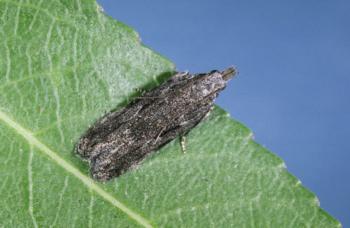Peach twig borer

Pupae are 0.25 to 0.4 inch long, brown in color and lack a cocoon. Pupation takes place in protected places on the tree and occasionally in the stem cavity of infested fruit.
Adult peach twig borer moths (see photo above) are 0.3 to 0.4 inch long with steel gray, mottled forewings. The long, narrow forewings are lightly fringed; the lighter gray hindwings are more heavily fringed. Prominent palpi on the head give the appearance of a snout. The bluntly oval eggs are yellow white to orange and are laid on twigs, leaves, or on the fruit surface.
Peach twig borer overwinters on the tree as a first or second instar larva within a tiny cell, called a hibernaculum, usually in crotches of 1- to 3-year-old wood, in pruning wounds, or in deep cracks in bark. The overwintering site is marked by a chimney of frass and is especially noticeable when first constructed or before winter rains set in. Larvae emerge in early spring, usually just before and during bloom, and migrate up twigs and branches where they attack newly emerged leaves and shoots. As shoots elongate, larvae mine the inside, causing the terminals to die back. Dead shoots are known as shoot strikes or flags. Adults from the overwintered generation usually begin emerging in April or early May. First generation larvae usually develop in twigs during May and June and give rise to the next flight of moths in late June or early July. Larvae from this and subsequent generations may attack either twigs or fruit depending on fruit maturity and population density.
(Description from UC Pest Management Guidelines)

